Antique Cars, Adventure Park, Gardens, Hollywood Costumes and Hidden Hollow
By Karen Rubin, Travel Features Syndicate
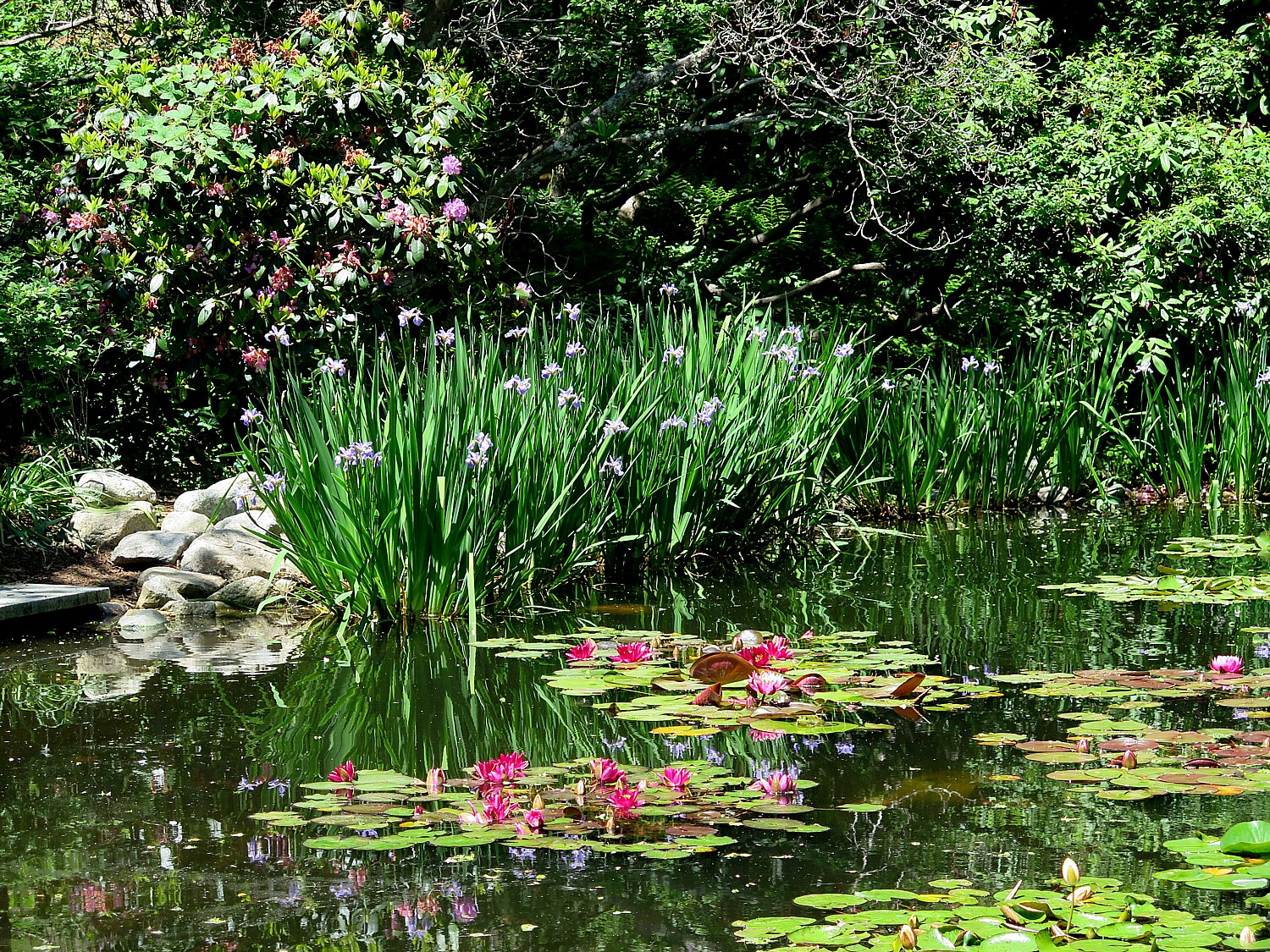
Heritage Museum & Gardens in Sandwich, Cape Cod’s first settled village, is a world-class destination attraction that on its own qualifies to bring people to Sandwich, even if the village did not offer as many unique attractions as it does or Cape Cod did not have its magnificent beaches and bike trails (see story).
Heritage Museum hits on a spectrum of cylinders -the vast, stunning and notable gardens, the historic collections of rare automobiles, the art inside and out, the way the entire place engages people of all ages – such as at the Hidden Hollow, a giant tree house in a hollow where you are invited to participate in planting and other activities (you feel like an elf or those tiny creatures in the EPIC animated movie). There is also – imagine this – an adventure center where you can see the forest “from a squirrel’s point of view.”

Set on 100 acres of magnificent grounds and trails on the banks of Shawme Pond in Historic Sandwich. Heritage Museums & Gardens is the largest public garden in Southern New England..Heritage is especially famous for its Dexter Rhododendrons as well as an encyclopedic collections of daylilies, hostas and hydrangeas. Heritage also holds a nationally-significant collection of specialty gardens, water features and sculpture.
It is a place where kids have space to really explore, where parents and children can engage in activities together, where parents can feel like kids again riding a carousel, and where children of all ages can feel that sense of wonder and delight, where the best of Mother Nature and man’s inventiveness achieve a harmony.
CUT! Costume and the Cinema
There are always special exhibits and this year’s is a blockbuster: “CUT! Costume and the Cinema,” which also provides a theme for many of the performances and special events throughout the season.
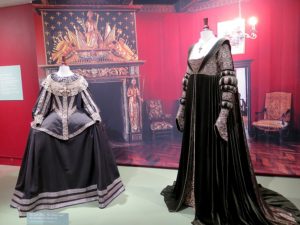
Forty-three costumes represent five centuries of fashion and style as interpreted by award-winning costume designers and worn by favorite stars are on display along with props, movie clips and photos and movie memorabilia. You actually get to see the scene where the actor is wearing the costume. But unlike seeing the costumes on film (where you might only get a view from the front), you get to see them in 360-degrees around, in very close proximity, and can appreciate the texture, the sumptuous fabrics, the lavish lace and embroidery and unparalleled craftsmanship and creativity the detail,
Costume is the essential ingredient in the authenticity of a period film..They set the scene and help create the ambience. They also reveal clues about a character’s status, age, class and wealth as well as his or her role in the story. And in this exhibit, you also get to appreciate changing cultural mores over time and place. More than 30 characters from some 25 films are displayed.
You can see Keira Knightley’s and Johnny Depp’s costumes from “Pirates of the Caribbean”; Kate Winslet’s from “Sense and Sensibiility”, Robert Downey Jr. from “Sherlock Holmes”, Minnie Driver and Emmy Rossum’s from “Phantom of the Opera”, Renee Zellweger from “Miss Potter.” Also, there are costumes that have been worn by Scarlett Johansson, Julie Christie, Maggie Smith, Heath Ledger, Ralph Fiennes Randy Quaid, Jude Law, Robert Downey, Jr.,
Anjelica Huston’s dress from “Ever After” provides an example of the technique of “slashing” – which was started by peasants who salvaged worn garments, and then was expropriated by the rich who embellished their sleeves with decoration.
Many of these costumes and their designers have won major awards including Oscars from the Academy of Motion Picture Arts and Sciences and BAFTAs from the British Association of Film and Television Arts (my only complaint is that the displays don’t credit the designers names or whether they won an Academy award for it).. The exhibition tour is organized by Exhibits Development Group, USA in cooperation with Cosprop, Ltd., London, England.
There are docents at the exhibit who field questions and respond to visitor requests – so, in response to visitors, they created a “cue sheet” of the movies, and a docent has swatches of comparable textiles so you can feel what they are like (do not touch the actual costumes). (I would have liked if they also would have provided the names of the costume designers and whether it won an award).
Many of these themes also animate weekly performances in an outdoor space where families like to bring picnics- especially the “Finding Neverland” and Beatrix Potter (“Miss Potter” who wrote the Peter Rabbit stories).,
Driven to Collect Antique Autos
One of the eternal delights at Heritage Museum is Driven to Collect, showcasing Heritage’s permanent collection of antique and classic automobiles, housed in a fantastic two-story building that is a reproduction of the Round Stone Barn at Hancock Shaker Village.
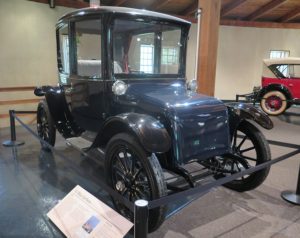
The JK Lilly III collection includes antique cars going back to the earliest models, most notably that are not just rare but also are in superb condition. You can see the model of the car that Amelia Earhart owned, the 1932 Auburn boattail speedster like Errol Flynn owned. Most interesting to me is a 1915 Milkin Light Electric Car, one of the first specifically designed for women: it did not require a crank, was elegant looking, with big windows.
New this year are a 1934 Derby Bentley reminiscent of the cars, time periods, and luxury represented in the 2016 special exhibition CUT! Costume and the Cinema, and a special display of maps made from recycled license plates, created by artist Stephen Blyth.

This collection includes some extraordinarily rare cars, like the Dusenberg that was specially built for Gary Cooper in 1931 (at a cost of $14,000-imagine that, in 1931). There is a 1919 Pierce Arrow, (original price, $7,750), built by the company, founded in 1901, by George N. Pierce of Buffalo, who built bicycles and bird cages, and turned his latent genius to automobiles. Also notable in the collection is the 1909 White Steam Car Model M, the first “Presidential” automobile, complete with Presidential seal, used by President Taft.
The descriptions are wonderfully “user friendly” that will delight true automobile collectors and aficionados, as well as neophytes. The commentary discusses the innovations made in the car, such as how the 1932 Auburn “boattail speedster” has a hidden convertible top (an awesomely exquisite car purchased, originally, for $975). Children are invited to hunt for clues and there are interesting kid-friendly descriptions. And there is a Model T that you can pack into and pose for pictures.
Each month from May to October, there is an opportunity to go behind the scenes with curator Jennifer Madden for a tour of the antique auto collection storage. Jennifer shares little-known facts and stories about the 20 cars in this area, while participants have the opportunity to closely examine the vehicles. Participants will also learn how the collection was formed, the original purchase price of each vehicle, the work that goes into maintaining this world-class collection, and the ins and outs of moving the cars and preparing them for exhibit. Advance registration is recommended as space is limited.
Lilly, of the Indianapolis pharmaceutical company (he came to sail in Cape Cod and stayed), was a phenomenal collector. Indeed, you see local and folk art and a range of items on display (the exhibit changes) that rivals the Smithsonian in Washington DC.
J.K. Lilly, III founded Heritage Museums & Gardens in honor of his father, J.K. Lilly, Jr., who spent a lifetime amassing great collections of rare books, coins and stamps, as well as American firearms and military miniatures. A private man, his father built a museum behind his home and shared his collections with few others.
But JK Lilly III took a different approach when establishing Heritage Museums & Gardens. He hoped that his museum would provide a range of educational and enjoyable experiences for many visitors “beyond Sandwich and beyond Cape Cod.” In order to augment the collection he acquired from his father’s estate, Lilly collected thousands of items in a short amount of time. This allowed him to present a broad overview of his ideas about the “excellence and ingenuity of American craftsmen.”
Heritage Collection Showcases Americana
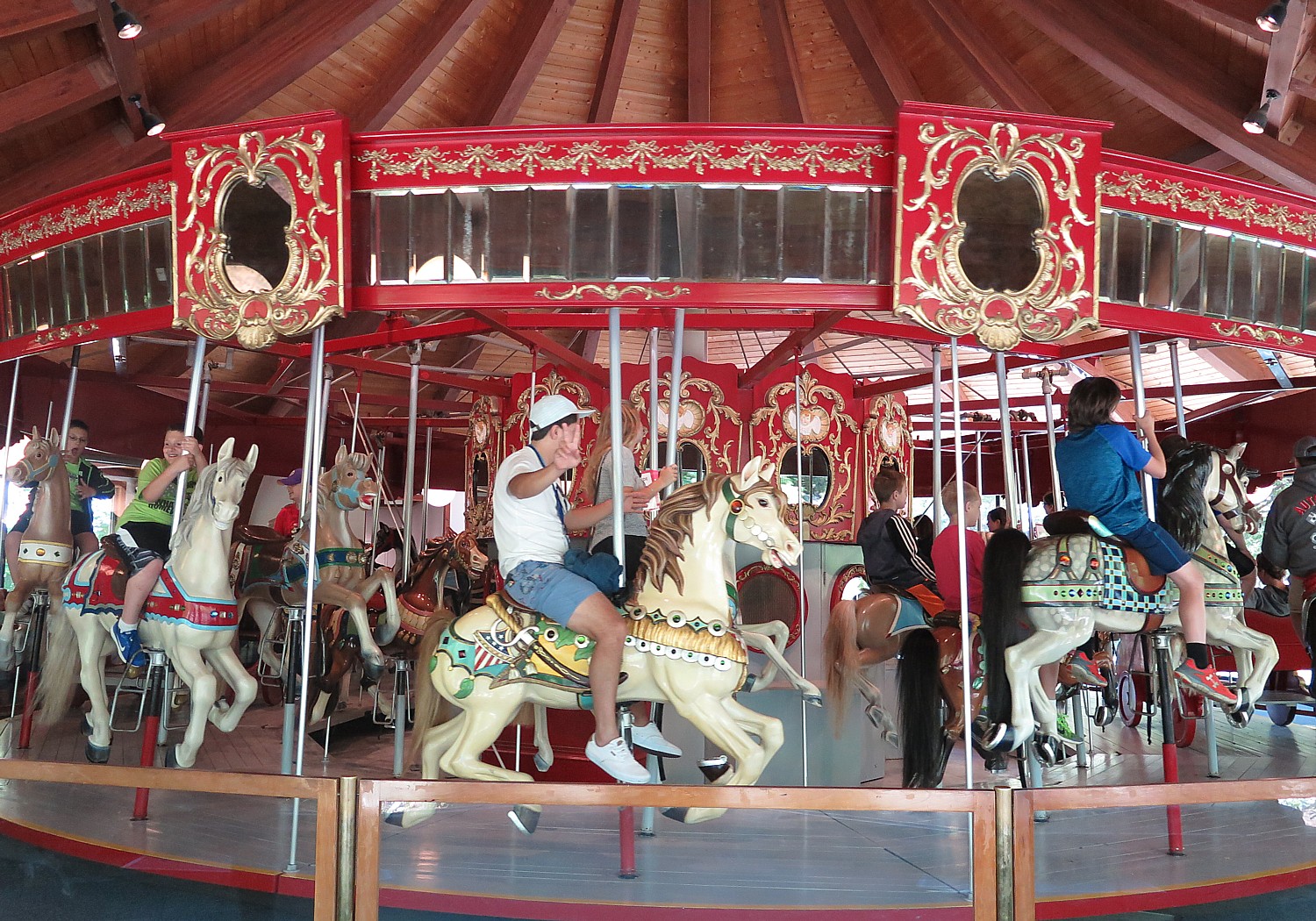
The Heritage Collection, in a separate building (where there is also the historic carousel you can ride) highlights art and artifacts from Heritage’s collection of more than 12,000 items. Beautiful paintings, rare objects, and the famed military miniatures offer examples of American ingenuity and excellence, and collectively, provide a revealing portrait of American culture over time.
The Heritage Collection presents Heritage’s permanent collection in four themes that permeate American history – sense of place, home, work and conflict of ideas. Each object seen here, pivotal or humble, tells a story about our history, about ourselves, and like all good history, about our future. Exhibit highlights include: beautiful paintings, rare objects, carved birds by A. Elmer Crowell, and the famed military miniatures offer examples of American ingenuity and excellence. . Indeed, it is very much like the experience you have when you visit the Smithsonian Institution in Washington DC.
Children of all ages will enjoy taking a whirl on the carousel in the building housing the Art collection (you can pretty ride as many times as you like).
Made by Charles Looff in 1908, the antique hand-carved carousel has been thrilling riders for a hundred years.
Gardens of Delights
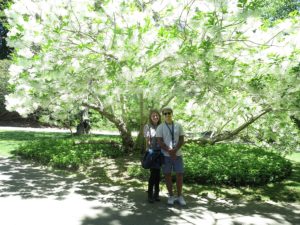
The grounds are simply breathtaking – magical even. I watch as a new garden is being created: it is a test garden for North American Hydrangeas – varieties not seen before on the market –to see how the varieties grow. We come upon a Fringe Tree – massive and delicate, like nothing I’ve seen before.
Most fun is how you come upon visual delights, from the Old East Wndmill, to the Labyrinth, to the Garden Maze, to Hidden Hollow, to a series of outdoor art-installations which connect to the natural world.
There is the most magnificent lily pond with a flume that creates a sculpted waterfall, outdoor art installations (that are like a scavenger hunt).
As you walk about the grounds, you come upon the Old East Windmill, built in 1800 in Orleans, Massachusetts, served that community for 93 years grinding wheat, rye, barley and salt from the local salt works. During the Civil War, the windmill also ground corn meal to be used as field rations for Union soldiers. In 1968, the windmill was sold to Heritage’s founder and moved to its present location.
Opened in 2004, the Hart Family Maze Garden was designed to capture the mystery and intrigue of exploration that characterizes a classical maze while providing a format for display of Heritage’s vine collection. Inspired by the site’s views of the surrounding landscape, the New England climate and the vines themselves, the maze uses a range of materials. A combination of evergreen and deciduous vines and hedges alternately create opaque walls and transparent windows the outside depending on the season. Throughout the season, the maze will feature such flowering vines as wisteria, clematis, honeysuckle, silvervine fleeceflower, Japanese hydrangea vine and five-leaf akebia.
Throughout the grounds, you will come upon these marvelous art installations – 10 in all – that have connection to the natural world and the environment – like a scavenger hunt for kids to find them all. Each year there is a similar, juried outdoor art show. This year’s is titled, “Natural Threads”.
Hidden Hollow
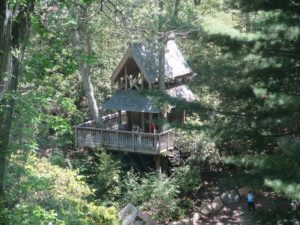
Relatively new is Hidden Hollow – a giant tree house in a hollow in the woods where kids and adults engage in outdoor discovery activities like planting and STEM activities.
Hidden Hollow is a place for families to play in and explore the natural world. Hidden Hollow features a wide range of activity areas in which families can enjoy the outdoors together. Nestled in a two-acre dry kettle hole, its unique topography offers a stimulating and beautiful outdoor setting for discovery and learning.
Children can climb stepping stumps, navigate log balance beams, construct forts, create nature-inspired art, build with blocks, dig in sand, experiment with water, make music, engage in sensory investigation with plants, and more.
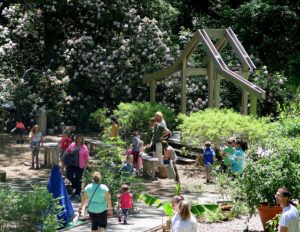
© 2016 Karen Rubin/news-photos-features.com
Hidden Hollow is one of New England’s first certified Nature Explore Classrooms, a joint program of National Arbor Day Foundation and Dimensions Educational Research Foundation.
This national initiative was developed to advance the understanding and appreciation of the natural world and to provide children with meaningful and positive experiences with nature.
Indeed, you may well come upon the children from Heritage Museum’s new Relatively new: 100 Acres School, a private pre-school focused on STEM education, where the 100 acres of the museum and gardens are the outdoor classroom where kids get to experiment, learn about plants, etc. The curriculum is being tested for use in other cities and the plan is to develop an online curriculum that can be adopted more broadly.
Adventure Park: See Forest from ‘Squirrel’s Perspective’
There is also a new adventure park where you can see the forest from “a squirrel’s perspective”.
Located on four wooded acres on Heritage-owned land that has not been previously open to visitors, The focus of the Adventure Park is to provide a forest experience – in the air and on the ground -, with many opportunities for learning about forest formation, history, workings of a forest ecosystem, interdependence and interactions within forest ecosystems, forest succession and human impact on ecosystems
There are five aerial trails through the treetops. Over 60 tree to tree bridges and 7 zip lines challenge your strength, strategy and balance. Like a ski mountain, each trail is color coded for difficulty, allowing beginners to experts to select their own challenges. Climbers as well as non-climbing observers will also enjoy the interpretive pathways on the ground, filled with educational information about the forest ecosystem.
The aerial trails afford views of some of the nicest Rhododendrons on the property. You get to see a typical New England forest ecosystem that includes several tree species, high bush and low bush blueberries, mountain laurel and other shrubs and may well see squirrels and chipmunks and a variety of local birds, including chickadees and finches, and if you are lucky, Heritage’s resident red-tailed hawk.
The Adventure Park is so popular, you need to buy a timed ticket (which you can do in advance).
Heritage’s history Goes Back to Early Settlement
The tract of land now known as Heritage Museums & Gardens played an important role in the history of the town of Sandwich. In 1677, Lydia Wing Hamilton Abbott was the first resident to live on the land. As the widow Hamilton, she resided with her two sons on a spot near what is now the Special Exhibitions Gallery just south of Upper Shawme Pond. She lived there in great poverty despite a second marriage and assistance from her family and the Quakers of the town. After her death, Lydia’s brother Daniel Wing, Jr., and his two sons, Samuel and Zeccheus, bought Lydia’s little house, now known as Orchard House. Samuel, his wife and six children lived in the house until the children married and moved away. Much of the Wing family farm remains part of the grounds of Heritage. Although members of the Wing family have not lived on the property for years, their heritage remains a vital part of our history.
The internationally-known Charles Owen Dexter, a successful textile manufacturer in New Bedford, was the next owner of the land. He bought the property, then known as Shawme Farm, in 1921. A true renaissance man, he was active in civic affairs as well as a photographer, violinist and yachtsman. At the age of 59, Dexter was told that he wouldn’t have long to live which led him to purchase Shawme Farm. However, despite the warning, he lived for another 22 years. Beginning in 1921, Mr. Dexter and his wife spent summers at the farm and for the next 15 years he worked in his garden hybridizing plants. He started with vegetables and expanded his interests to rhododendrons.
The Lilly family, originally from Indianapolis, Indiana, spent their summer vacations in Falmouth, so when Josiah Kirby Lilly wanted to found a museum dedicated to his father, he chose Cape Cod.
Lilly first thought that he would create an automobile museum, but after researching other institutions, he decided that it would not have a broad enough appeal. It was after his father’s death in 1966 that the idea of creating a public place to house several of the Lilly family collections began to take shape.
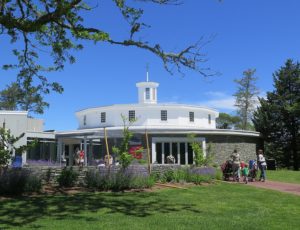
After J. K. Lilly, Jr. died, his son bought the antique firearms and military miniature collections from his father’s estate. With architect Merton Stuart Barrows and landscape architect Philip Ansell, he planned the buildings and grounds to be a suitable background to showcase the collections. They decided on a replica of the Round Barn from the Shakers of Hancock Village in Pittsfield, Massachusetts for the cars. A replica of the Temple of Virtue from New Windsor, New York, where George Washington awarded the first Purple Heart to a soldier, was selected to hold the antique firearms and the military miniatures. Plans were made to add the gatehouse (ticket office and museum store) and the Old East Mill, from Orleans. In 1971, to entice more women to the museum, Mr. Lilly bought the Charles I. D. Looff carousel. Housed in a building built especially for its display, the carousel would be joined by three galleries holding American art.
Today the Museum serves more than 100,000 visitors annually who come from around the world to visit.
An an outdoor stage, family friendly concerts are presented Fridays 9-5, offering an entire day of activity. The theme this year is movies, such as “Cinderella,” “Neverland,” and “Beatrix Potter Day.” (And check out the schedule for special evening activities and lectures).
Bring a picnic or purchase food from the bistro-style Magnolia Café.
It is easy to spend a full day (or more) at Heritage Museums & Gardens, enjoying both The Adventure Park and the main museum grounds including the Auto Gallery, the Carousel, the Windmill, and the various gardens and indoor exhibits. You’ll need at least 2.5 hours for The Adventure Park and at least 2 hours for the museum (and you need a timed ticket to visit the Adventure Park). Save time and pre-purchase tickets.
And if you are planning to visit more than one time during the season, it is really worthwhile to purchase a family membership. (Open daily, mid-April to mid-October, 9 am-5pm).
Heritage Museums & Gardens, 67 Grove Street, Sandwich, MA 02563, 508-888-3300, [email protected], www.heritagemuseumsandgardens.org.
See:
Time Traveling in Sandwich, Cape Cod’s First Village; Dan’l Webster Inn & Spa is Perfect Time Capsule to Cocoon Visit
____________________
© 2016 Travel Features Syndicate, a division of Workstyles, Inc. All rights reserved. Visit goingplacesfarandnear.com, www.examiner.com/eclectic-travel-in-national/karen-rubin,www.examiner.com/eclectic-traveler-in-long-island/karen-rubin, www.examiner.com/international-travel-in-national/karen-rubin and travelwritersmagazine.com/TravelFeaturesSyndicate/. Blogging at goingplacesnearandfar.wordpress.com and moralcompasstravel.info. Send comments or questions to [email protected]. Tweet @TravelFeatures. ‘Like’ us at facebook.com/NewsPhotoFeatures
